|
Recent work done by Evans and Doswell (2001) and Gale et al. ( 2002) suggest that the storm-relative inflow may also be important in determining whether a† MCS will be long lasting or not.† Both the surface system relative inflow and elevated system relative inflow tend to decrease as an MCS nears dissipation,† due in part because of the decrease in the speed of movement.††
|
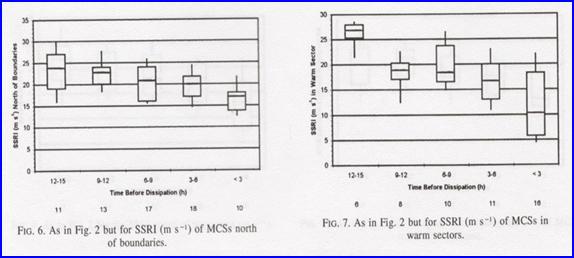
|
The figure above show box and whisker diagrams of the surface system-relative inflow (SSRI) versus time until dissipation for MCSs north (left figure) and south (right figure) of a boundary.†† The SSRI for long lasting MCSs is much stronger for the long lasting MCSs versus the shorter lasting ones, especially south of the boundary.† The same holds for the elevated system relative inflow (ESRI) as shown below, especially those in the warm sector.†
|
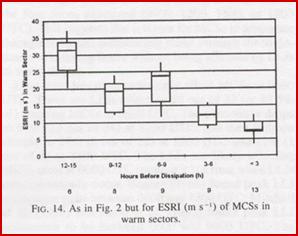
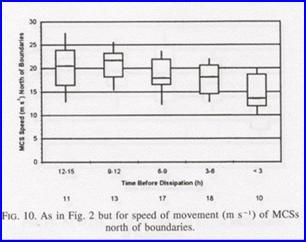

|
System relative inflow is strongly related to system movement and the mean wind of the cloud bearing layer.† Therefore, rapid moving systems should be associated with strong system-relative inflow.† Therefore,† it is not surprising that faster moving MCSs typically last longer than slower ones since they should be associated with stronger system relative flow. |
|
Gale et al. also noted that MCSs that were affected by the low-level jet at some time during their life cycle often weakened once they were no longer being influenced by the low level jet.††† Systems with strong system-relative low-level inflow on the forward side of the system and weak storm relative flow at mid levels last longer than systems having weaker low-level storm-relative inflow.† The Gale et al. work also suggested that equivalent potential temperature advection might be a potential predictor of MCS dissipation since its advection decreased prior to MCS dissipation.†† |
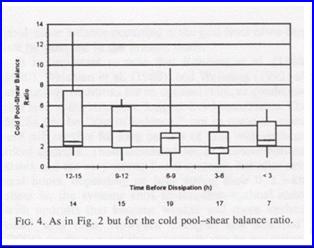
|
Rotunno et al. (1988) has theorized that the balance between the line-normal shear (the shear perpendicular to the linear convective system) and the evaporation induced cold pool circulation determines the structure of long-lived convective systems.† Weisman (1992) has suggested that the evolution of the rear inflow jet and whether it has descended to the surface or remained elevated could also play a role in how long a convective system lasts before dissipation.† Weisman and Rotunno (2004) have suggested that surface based shear distributed to greater than 5-km is detrimental to producing strong convective systems and that under these conditions that 2-D simulations show little sensitivity to changes in the upper-level shear.† However, the cold pool-shear (low level) balance ratio theory of Rotunno et al. has not been supported by observations (see figure below) and appears to play little role in determining how quickly an MCS will dissipate.† Note on the figure below how the mean cold-pool shear balance ratio is almost the same for the MCS that did not dissipate for 12 to 15 hours as for those that dissipated within three hours.†
|
|
From Gale et al.† 2002 |
|
From Gale et al.† 2002 |
|
From Gale et al. 2002 |
|
From Gale et al. 2002 |
|
From Gale et al.† 2002 |

|
From Gale et al.† 2002 |
|
How long will an MCS last before dissipation
|
|
One of the most difficult forecast problems associated with forecasting the precipitation associated with an MCS is deciding how long it will last.† Will it quickly weaken and dissipate or will it last into your forecast period.† In the shorter time ranges,† monitoring satellite and radar imagery to see whether the associated cloud tops are warming or whether the radar echoes are weakening may offer some clues about a systemís future.†† In the past forecasters have often relied on climatology to try to anticipate when the convection associated with an MCS will weaken and die.† For example,† many MCS weaken over the Plains and Mississippi Valley during the 1200-1800 UTC period.† However,† that presupposes a knowledge of the regional climatology of MCSs which may not exist and also assumes that all MCS over a region behave similarly.† |
|
Typically,† MCSs weaken and dissipate when they move into a region of reduced low-level moisture support and weaker forcing (Cotton et al. 1989).†† Each of these factors can often be related to weakening of the low-level jet either through diurnal weakening or by the MCS moving away from it.† However,† the former can also be a result of the weakening of the system-relative moisture inflow.†† Another factor in weakening may be that the system moves into an area where the airmass is less unstable and may actually be stable.† These unfavorable conditions lead to the weakening and eventual decay of the system.† |
|
The models typically do a much better job handling the temporal evolution of convective systems that are associated with strong mid-level forcing and do a poorer job in handling systems that have weaker forcing.† However,† even for the stronger systems,† the models may still have trouble handling an MCSs life cycle since they often have problems in predicting the stability (ie. CAPE) and also lack the sophisticated cloud microphysical processes needed to correctly simulate the development of the rear inflow jet.† Therefore,† a model may underplay the speed at which the MCS moves and therefore underplays the system relative inflow.†† |
|
Two articles by Coniglio and his co-authors (2001, 2006) indicate that adding upper-level shear to a wind profile with weak to moderate low-level shear increases the vertical displacement of parcels despite the† decrease in the vertical velocity along the cold pool interface.†† This research suggests that looking at the wind profile through the entire troposphere needs to be considered when trying to analyze how long a linear MCS will last.† |
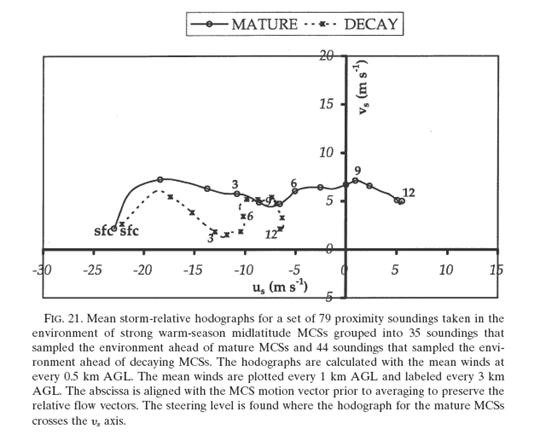
|
From Coniglio et al. 2006 |
|
There were differences in the structures of the storm-relative hodographs between mature MCSs and decaying ones. There was significant unidirection shear associated with mature MCSs with a mean steering level near 8-km which the article notes is often tied to pre-existing upper level jets.† The upper-level shear decreased significantly as MCSs decayed.† Coniglio et al. note that the decrease in upper level shear can often be related to the propagation of the system away from the upper level jet.† |